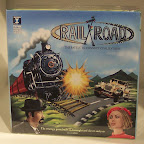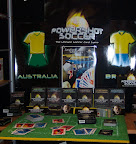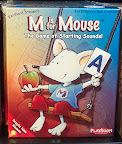Proudly wearing my Gone Gaming "Media" pass, I waved the flag for boardgames (and, incidentally, for the Australian Games Expo – I think the organiser should put me on a retainer!) and scoped out what we can expect over the next year.
A poster (PDF, 1.2 MB) and brochure on "Fun and Play with toys" were available at the entry to the fair. The brochure is excellent, looking at the value of play - while it doesn't directly talk about boardgames, the quotes in it relate to all different types of play. The poster talks about "fun ways to spend 30 minutes" and is something I could see being featured quite prominently in kindergartens (preschools) and childcare centres. It includes "host a boardgame championship" and "design your own board game together" - although it also includes "Why not use your toys to re-create a soap opera like 'Neighbours'?" ...
(Note: I can't find the brochure on their website but I did find this fact sheet on the value of play.) (PDF, 1.2MB)
The message of the fair was 'licensing' – there were licensed games everywhere. Weirdest licensed property, I think, was the "Biggest Loser" boardgame – something there just doesn't sit right for me. "Learn about weight loss while playing a board game!" it screamed. I think I'd rather play Die Macher on a treadmill, thanks anyway.
There were a number of nicely-produced children's games around the fair, as well as the
Please note that all prices are given in australian dollars. US dollar prices are usually around 40% of australian dollar prices, but don't count on it.
Leisure Learning
– children's games |  |  |
The Spider's Web bills itself as a game of escape, in which 1 player takes the role of the spider and the others play the flies. A quick scan of the rules suggested that it was a fairly simplistic roll-and-move game, but it did have a sticker proclaiming it the winner of the Creative Child Magazine Game of the Year award for 2006, as well as of several other awards.
This company featured a few other games quite prominently: Sentence Says, Pet Detectives, 'Bouta Face and Roundabout (probably the most interesting of the lot – a 2-4 player dice-based game with abstract qualities - it looked quite aggressive)
Games Workshop
Games Workshop's stand was next. This featured their retail lines, including a new range of miniatures and their Citadel "Foundation paint" range, which they told me will "revolutionise the hobby" by reducing the need for layering of different paint colours. I'm not a minis gamer, but I was impressed with this new range of paint – it gives good coverage, good colours (even over black) and still leaves the detail on the miniature clearly visible – I saw this demonstrated with chainmail. There will be a range of online articles about painting with this range, as well as support in White Dwarf magazine. And it comes in 18 new colours (they sent me away with a sample pot of purple – now I just need to decide what gets painted before my kids find it).
Ventura Games
 |  |  |
Ventura Games is one of the major games importers and publishers in Australia, and the staff have a real commitment to promoting (and playing) boardgames. Among other things, they publish a version of Carcassonne locally, making it much more affordable than other imported games. As well as labelling one of their stands "German and Strategy games," they had 'our games' scattered across their booth. I've never seen Polarity for sale in Australia, but Ventura were one of at least three distributors who were ranging it at the fair – its new box makes it a much more saleable item both for and to retailers. The newest game I saw here was Klaus Teuber's Struggle for Rome.
Ventura also stock the Gamewright children's range, as well as a full range of chess and poker products. Their featured title was the Wildlife DVD game (International Toy of the Year 2007 at Nürnberg). Also promoted were the "Find it!" puzzles. These are tubes full of coloured beads. Each tube also contains a range of items that are listed on each end - basically, you shake the tube and mark the items off until you have found them all (a feather, a toy elephant, ...). These will go well on shop counters as once you start fiddling with one you tend to keep going.
Weirdest product was probably the "Shuffle up playing cards" – I'm still not sure I like this idea. BoardGameGeeks questioned the need for the product but we're not really its target market. I suspect there is a market there in people who don't currently play cards – and also possibly for people with a disability that makes it hard for them to grip regular cards. I doubt they'll be a big seller, though.
Funtastic
The next stand I visited – Funtastic – had strict rules against taking photos (I took one before I realised and the security guy told me off, then stood over me and watched my camera to make sure I deleted it). They had a range of licensed games, including quite a lot of Bratz games (Baby Bratz Storybook Collection 3D Memory Match; Bratz Genie As You Wish Board Game; Bratz Sweetz Party Board Game; Bratz SleepOver Board Game; Bratz Game Mall Crawl; Bratz P4F Board Game; Bratz Charmed Life Board Game) and a massive range of DVD trivia titles (Australian football, World War 2, Cricket, Cinema), and were heavily promoting a game called "Eternity II" – "the puzzle and the $2 million prize". There was no information about how to play it, or what it was about – but there was lots of fake money around the displays! I guess that was enough to get people to order it. Worldwide launch date is 28 July 2007 so I guess we will probably hear something more by then. The order form suggests that it will retail in the $50-$60 price bracket, with hint packs sitting around $25-30
My favourite of everything at this stand was Speed Stacks. Yes, folks, there is now a game of competitive cup stacking. Give me enough sets of these, and I could actually build my giant game of The Bucket King. It even comes in pink!
JP Toys
JP Toys had a game based on the popular travel show Getaway. It's a follow-up to another successful Getaway title they've had in major stores like Target for around 12 months, and it will be out in June-July, priced around $30-$35. Players pick up an itinerary card, and must visit a number of different locations by answering trivia questions about recent events. Sometimes they have to take a detour. I had no opportunity to play this, but nor did I really want to. It will probably do well just off the back of the Getaway brand, but it struck me as unimaginative and dull, with questions about that were recent but unlikely to be remembered in a couple of years.
JP Toys also stocked a range of Popomatic games, 3-D Snakes and Ladders and Jungle Jitters, a talking version of Barrel of Monkeys. My pick of the stand, though, was the Dora the Explorer water dispenser - I'll pass on the games.
Even Toys and Games
- Playroom |  |  |
After those last two booths, Even Toys and Games was a delight. They are the Australian reps for Reinhard Staupe's Playroom titles, as well as Spy Alley, which was the Australian Games Association's 2005 pick for Game of the Year, Killer Bunnies and a range of other titles. The staff are friendly and knowledgeable and the products excellent – what's not to like? We had a sneak preview of the packaging for Bull in a China Shop (VERY different from our much-more-grown-up-looking German Elefant im Porzellanladen) and In Limbo. We enjoy Elefant and were underwhelmed by Diabolo but it should do well for non-gamers – reception at the fair was very positive. I think the very cartoonish packaging may make Bull in a China Shop a harder sell, which is a shame. Another title they were promoting heavily was Cinematique, which looks like a movie trivia game for dedicated movie buffs.
The new Playroom title, M is for Mouse, comes with three different rulesets of varying difficulty – one which we would play with Otto, one which we would play with Biggie, and one which we'd leave to Biggie and her friends because we wouldn't be evenly matched with her. Like the rest of the range, it looks like a very strong children's game.
David from Even Toys and Games spoke very highly of Cogno, a science/general knowledge game. I'll reserve judgement on this one – it looks like it could fit in well for classroom/curriculum support use but I doubt it's going to be on our list of fun family games.
JEDKO
– boardgames & puzzles |  |  |
JEDKO, a local wholesaler with a significant retail presence in Melbourne and online, had a reasonable-sized stand with some Euros and American games displayed, as well as a big display of "garden games". They shared their stand with Adelaide-based company Imagination, who have had some success on the international market with – you guessed it – licensed DVD product. Their products feature the hosts of the appropriate TV shows – their Deal or No Deal has sold a million copies in the USA, Family Feud II around 300,000. In their "Board Games" range they have the Tetris Cube puzzle (I suspect it's a rebadged soma cube) which can be branded for companies in their colours and/or with their custom pattern. They're also selling LCR, Fact or Crap, Backwords and a Travel Trivia Challenge, none of which looked particularly exciting to me, although all are likely to be popular in the retail channel. They have two new games coming out soon. Snipe It is a trivia game where the last person to buzz in with the correct answer wins the point. Mind Twist looked potentially more interesting, but all I have is a box and a blurb from a catalogue: "Take a deep breath, and dial up 1 of 3 numbers. Will your opponent guess correctly, or can you fool them in order to move ahead? It's a battle of nerves, brains & wits, with an added twist." From a design perspective, it looks pretty impressive on the box (although there wasn't even a prototype available to fiddle with at the fair) – I have, obviously, no idea about the game play.
BLUE OPAL
– Some new Australian games |  |  |
The next stand I visited was Blue Opal, where I met Darren McMurtry and Colin Stott. Darren and Colin are the designers of Game as Ned Kelly, due out in June at around $40-$50 retail. This game is for 2-20 players, playing in two teams: the police and the Kelly Gang. It's a roll-and-move, but players have several pieces and can choose which piece they want to move and in which direction. The police aim to capture the Kellys and put them in the Old Melbourne Gaol; the Kellys aim to give away all their money (13 £1 notes) and escape to New South Wales. It looks like a fairly straightforward children's game with a reasonable combination of luck and strategy. There's an action card deck, but it is not reshuffled when it is exhausted; the game continues without action cards. It's nicely produced: the playing pieces are helmets and the sides of the box give information about the history of Ned Kelly. The game is pitched at ages 8+ which ties in nicely with Australian history in the school curriculum, and I'd expect it to be popular as a souvenir from museums like Sovereign Hill as well as in the regular retail channel. They also make a lightweight polypropylene Ned Kelly helmet which should be a hit.
Darren and Colin have also designed True Lies, a party game for ages 7+, which will be released in May. In True Lies, one player draws a card which says, for example, "This card has the word COUNTRY." They then EITHER read it out verbatim (truth) or they change the word on the card: "This card has the word ACTOR." (lie). All the other players now bet on whether they think the player was telling the truth – they have six cards each, allowing them to bet 1-3 movement spaces on whether the player is telling the truth or lying. If their bet is correct, they move the number of movement spaces shown by their card. The person who read out the card does not move. I think this will go over well as a light party game and it should be playable by adults and children together or separately. The board is not really necessary but it does list the words on the cards, so that inexperienced players won't show their lies by using a word that isn't included ("This card has the word GUATEMALA.")
The Blue Opal stand was also home to one of the expo's funnier moments. They had someone wandering around the expo dressed as Ned Kelly, to promote their new game. Ned had attracted plenty of attention – including that of Tony Faber-Castell (of Faber-Castell stationery), who appeared at the stand in his own Ned Kelly helmet, made of Faber-Castell Connector Pens, complete with his own gun (also made of pens). I didn't see the shoot-out, but I saw Ned later, and he had replaced his gun with the Faber-Castell one, so I am guessing that the outlaw won.
Crown and Andrews
– traditional boardgamesCrown and Andrews had the usual traditional and TV tie-in boardgames, as well as a couple that looked interesting. This was where I saw the Biggest Loser tie-in game I mentioned earlier.
Make 5, designed by Matthew Browne, is a game of short words for 2+ players aged 8 and up. Each player has a sheet with a 5x5 grid. Players draw a card which shows a letter, and they fill it in somewhere (secretly) on their grid. The object of the game is to fill in your grid so as to make it show the most words.
Gibberish seemed to be some variant on competitive Mad Libs. It actually looks like something that Biggie and I might enjoy – I am a sucker for light word games, and this looks a similar weight to Scattergories.
Sorts was another new twist on an old idea. It's a trivia game, but instead of finding one answer to a question, players must identify which answers are true and which are false. For example: Which 3 of the following are insects? Fleas, butterflies, termites, dolphins, ticks. This one is a variation on a theme (trivia) that I think is pretty tired, and my suspicion is that the questions are too tricky for it to really appeal to the 8+ age group that I think the game is targeting.
The stand-out game at Crown and Andrews, though, beyond a shadow of a doubt, was Frog Tennis. I think this game rivals even the great Loopin' Louie.
(Answer: fleas, butterflies and termites are insects. Ticks are arachnids. Dolphins are neither.)
The Dr Wood Challenge Centre
- A new Australian entrant to the games market. |  |  |
The Dr Wood Challenge Centre, an Australian company based in Brisbane, produced the "Kaleidoscope Classic" puzzle which was popular a couple of years ago. I understand it has done particularly well in Europe.
This year, they are launching a number of games onto the market. I played a couple, and looked at others.
The first Dr Wood game I tried was Kaleidoscope enKounter, which is played on the Kaleidoscope Classic board. In this game for 2 or 3, players take it in turns to try to place their polyomino pieces on a board made up of squares in 3 different colours. Placement scores points for covering each space as shown on the board (there are several different boards available). Any leftover pieces at the end of the game are worth – 2 points per square. I was trounced quite resoundingly by Frank Dyksterhuis, one of the game's creators. While the game has obvious similarities with other games like Blokus (placing pieces on a board), the need to match patterns and the opportunity to vary the gameboard are quiet different and should appeal both to families and also to the more overtly educational market.
Another game based on the Kaleidoscope puzzle is kaleidoscope krusade. I didn't have a chance to play this but this looks more like a traditional game than the other Dr Wood games. It still incorporates the spatial puzzle-solving elements that seem to characterise the Dr Wood range.
Next up was Kingdom Quest. This game uses an unusual mechanic that I've not seen before. Each player has 5 cubes, which are the playing pieces. Each side of the cube is printed with a different character – the Queen, the King, the Princess, the Prince, the Court Jester and the Knight. On their turn, a player may either place a new cube onto their 'entry' square, or move another cube – by rolling it onto the next square, showing a different face. The object is to conquer the other players' pieces, which you do by moving one of your own pieces into an adjacent square, showing the right face ("facilitating an alliance"). So if I roll my cube to make my Queen face-up beside another player's King, my Queen captures that King. The available pairs are: Queen and King (conquer each other), Prince and Princess (conquer each other), Knight and Queen (conquer each other). In addition, a Jester is so funny that any adjacent Prince or Princess is captivated and cannot move until the Jester does. A "special" Genie cube allows players to turn an adjacent cube.
This game felt very abstract to me. I could see the themed artwork particularly appealing to teenage boys (I am afraid we have dubbed one of the pictures the "slutty princess") and I really liked the novel (to me) movement and conflict resolution mechanic. I'm looking forward to playing it properly.
RailRoad is another game from the same company. Players take turns to place tiles showing either road or rail track on the board (one player takes road, the other rail). Each piece has a different number of track 'connectors'. The object of the game is to have the fewest connectors left at the end of the game; if a player may completely enclose a space (including at the edge of the board) then the opposing player may not place any of their pieces in that area.
The Dr Wood Challenge Company will be at the Australian Games Expo in June and I hope to try out more of their games. These aren't "gamers' games" as such, but there is a little more to them than the very average games that we see in the shops, and I hope that they will do well. They should be popular with the education market, as each seems to be part puzzle, part game. Their stand was excellent and the team of demonstrators (including Dr Mark Wood and Frank Dyksterhuis) was enthusiastic and welcoming. The games are available now in Australia, and will be available soon in India. Kingdom Quest is going into Europe at the moment, and they hope to have their games in the US by the middle of the year.
 | The Dr Wood Challenge Company's other games were:
|
Divisible by Zero
The Divisible by Zero stand was busy when I passed, but Blokus was strongly represented, with a giant Blokus set on display at the front of their stand.
Divisible by Zero have done fantastic work promoting Blokus and ensuring its very wide availability in Australia.
Funatical
 |  |  |
Funatical are another big Australian games distributor. Their excellent stand featured Squatter, represented by its inventor Robert C Lloyd, who was absolutely delightful to chat with. Squatter is a favourite for Fraser and Biggie to play, and it is now over 40 years old.
Funatical had the Gigamic games range including children's versions and the new adult game, Tortuga; the GIPF range (which doesn't do well in Australia, for some reason); a range of Swedish children's games from publisher Användbart Litet Företag that they have just started to bring in; and many other games.
I was interested to see Khet, as well as the Eye of Horus Beam Splitter and photos of a prototype 2-level tower which actually reflects the beam up to the new upper level tower of the game.
Funatical were also looking at a copy of Zoch's San Ta Si which looks interesting not least because it is by Jacques Zeimet, designer of our new favourite gateway game, Bamboleo.
Powershot Soccer, a new card game from Singapore, looks like a winner. Each deck represents a different team in the soccer league, with a different spread of abilities. Players play 'matches' against one another and the word from those in the soccer know is that this is an engaging and well-thought-out game.
Funatical also had a couple of new Australian games.
Hotchpotch gives players 9 letters (including one 'mandatory' letter) which they must combine to make words. This reminds me of the 'target' puzzles in my newspaper which I do religiously for a few weeks every year before getting sidetracked by something else. It should do well in the Boggle space and should be popular with children and possibly also with older people who enjoy word puzzles.
Schmegeggie is a new Australian game, which will be released in mid-year. It's played with cards and tokens; mixed in with the regular cards are 5 'cancel' and 6 'schmegeggie' cards. Each schmegeggie card shows a different victory condition – but only the last one to be played will actually apply to the game. This sounds light and fun and is one to watch for.
Wrap-up
I hadn't been to a trade expo for years, and I forgot to wear my comfy shoes, which wasn't such a great idea. It was a good show to visit, despite the relatively low percentage of stands with boardgames and the lack of opportunity to actually try any of the games out.
It was disappointing not to see Ravensburger, Selecta and Haba represented at the fair. (Biggie will be disappointed that I didn't see any Winx Club branded anythings, either). Licensed properties, especially with a DVD, are clearly a big money-maker for companies; it's disappointing that there aren't more really good games of this type being produced. The companies that do buy and sell quality games are promoting them much more than in the past, but they're still a long way from the mainstream. Demo copies definitely help, as do enthusiastic and informed demonstrators.
Now if only I could find the name of the distributor with the life-size inflatable DALEK, my life would be complete.
More photos (disclaimer: they are happy snaps, not professional publicity shots!)
Happy gaming!
Melissa









